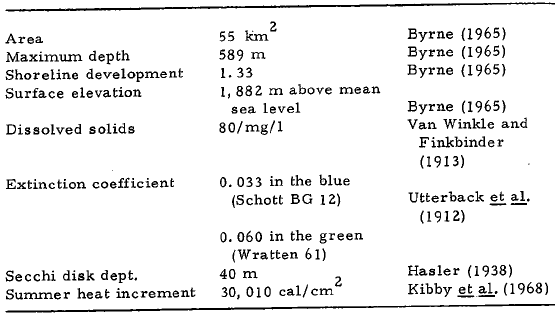The Horizontal Distribution and Vertical Migrations of the Limnetic Zooplankton in Crater Lake, Oregon by F. Owen Hoffman
INTRODUCTION
There is extensive literature on the horizontal distribution and vertical migrations of zooplankton in fresh water lakes. An adequate review is given by Hutchinson (1967). Studies in a wide variety of lakes indicate that water currents are the main environmental factor involved with the horizontal distribution of zooplankton, but vertical migrations may also mediate the horizontal distribution by utilizing different water currents at different depths.
In general, vertical migrations are best observed in lakes that are deep, transparent and unproductive. Worthington (1931) in the Lake of Lucerne found vertical migrations with amplitudes in excess of 50 meters. Past observations and experiments reviewed by Hutchinson suggest light to be the initiating, controlling, and orienting factor affecting die1 migrations, but chemical and thermal gradients may also determine the position of zooplankton.
Although the exact causes of vertical migration are not fully understood, predator avoidance (Manteufel, 1959), navigation (Mackintosh, 1937), increased gene flow (Carson, 1957), and a decreased “social stress” (Wynne-Edwards, 1962) have all been proposed as possible adaptive advantages. These are discussed by McLaren (1963) who offers the most recent and complete treatment of the adaptive significance of vertical migrations, McLaren, however, stresses that reproductive and growth advantages are gained through vertical migrations. He suggests that all necessary feeding is done at the surface while a greater size and fecundity are attained in the lower temperature of deeper waters. Because of its formation, location, and extreme depth, Crater Lake has unusual optical and thermal properties, and offers an unique environment for zooplankton investigations. It was the intent of this study to record the horizontal distribution of zooplankton by determining variations in density with time and location in the lake. Observations of the die1 vertical distribution of zooplankton were made in an attempt to record the timing and extent of vertical migrations under the unusual conditions of light penetration in Crater Lake.
With the exception of some preliminary studies, summarized by Nelson (1961), little is known about the horizontal and vertical distribution of limnetic zooplankton in Crater Lake. Brode (1938) reported Daphnia pulex maxima at 38 and 53 m, and Bosmina longispina maxima at 100 and 150 m. It was his opinion that D. pulex might undergo daily or seasonal vertical migrations. Kernrnerer et al. (1923) observed D. pulexmaxima a t 60 to 80 m in August and at 50 to 60 m in September. He also found B. longispina at 100 to 150 m. Hasler (1938) reported only on D. pulex whose maxima he found between 50 to 100 m during the summer of 1937. During the summer of 1940, Hasler and Farner (1942) found no g. pulex in tow-net samples from 100 m to the surface.
The Environment
Crater Lake is located within the collapse caldera of Mt. Mazama on the crest of the Cascade Mountains in southern Oregon. The near circular lake is the deepest in the United States and is fed entirely by natural precipitation. Its extreme depth, high surface elevation, and isolation with no permanent inflowing streams account for water that is quite low in minerals and unusually transparent (Table 1).
Throughout most of the year, the lake is isothermal, stratifying only during the warm summer months. This generally occurs from late June through late September. During thermal stratification the epilimnion is very shallow, the metalimnion existing between 10 to 20 m. Because of strong wind action, which gives rise to a high summer heat increment, Crater Lake seldom completely freezes over. The only major freeze was during February through April of 1949.
Table 1. Selected morphometric, physical and chemical characteristics of Crater Lake, Oregon.
***previous*** — ***next***


